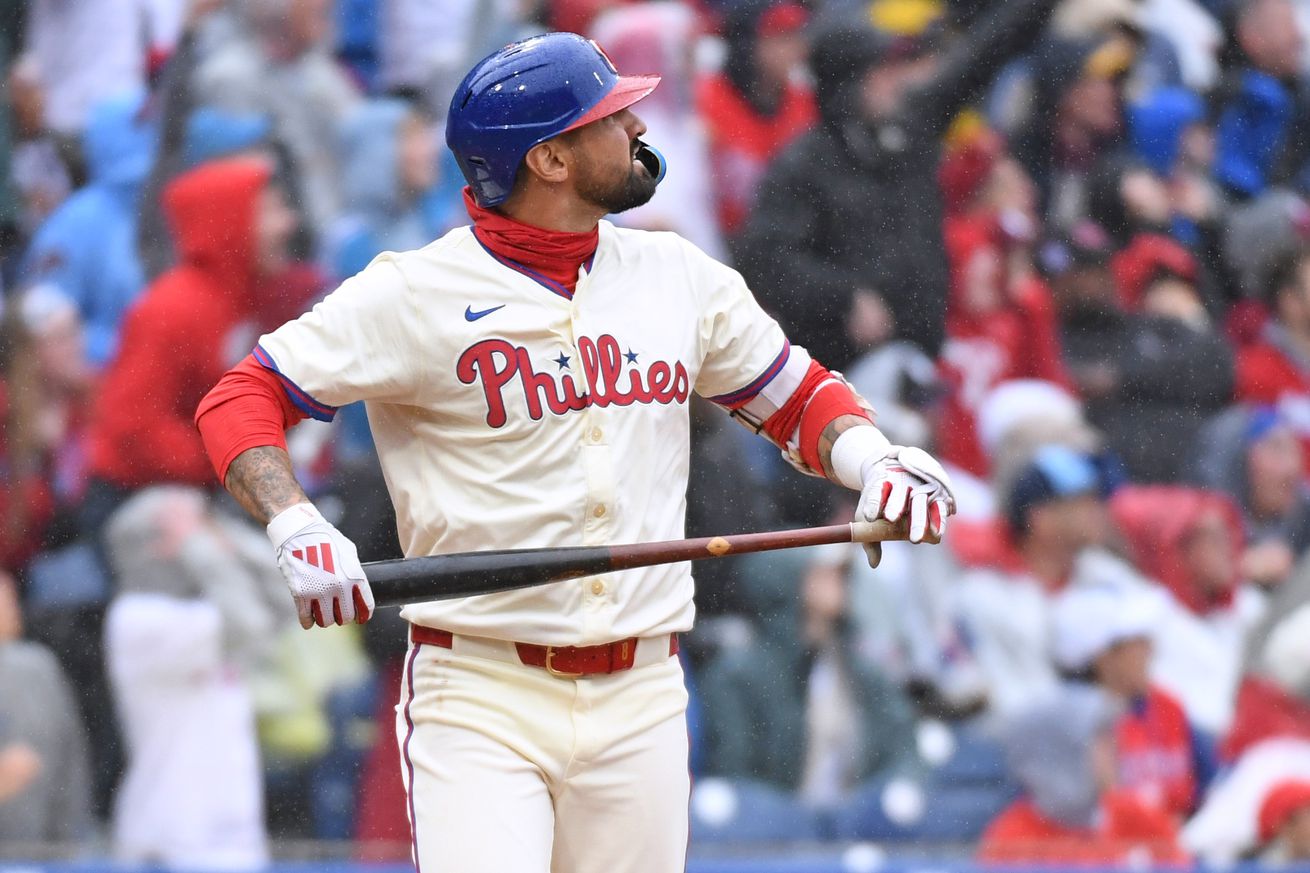
It’s a double-edged sword the Phillies know well.
The first pitch of any at-bat is crucial. The pitcher wants to get ahead with strike one. The hitter wants to get something to hit. In many cases, it can set the tone for the whole plate appearance.
For the Phillies, it may also end that plate appearance. Entering play on Monday, the Phillies hitters have swung at and put the first pitch of a PA in play 50 times on the season, tied for the third most with the Miami Marlins. They’ve swung at the first pitch in general a total of 109 times, tied for 15th most with the Chicago White Sox. The Phillies have swung at a first pitch out of the strike zone 19 times, good for a tie with the Mets for the third lowest rate in baseball. Conversely, the other 90 times they’ve swung at a first pitch it was inside the strike zone, the sixth most such instances in baseball.
All of this has resulted in Philadelphia being among the bottom half of the league in total pitches seen (17th) and frustrating innings like the ninth inning on Saturday where the Phillies were retired on three total pitches.
A THREE PITCH 9TH INNING!? pic.twitter.com/7swpepvBsb
— FOX Sports: MLB (@MLBONFOX) April 5, 2025
But let’s take a look at those three pitches. Below is the one that Bryce Harper hit to third base that was mishandled by Max Muncy for a single.

It’s not a very good pitch to hit, especially as a slider in a lefty-lefty matchup, but it would likely have been called a strike if Harper didn’t hit it. Regardless, he was able to turn it into a single.
Now here’s the pitch that Alec Bohm hit for a double play immediately after Harper reached base.
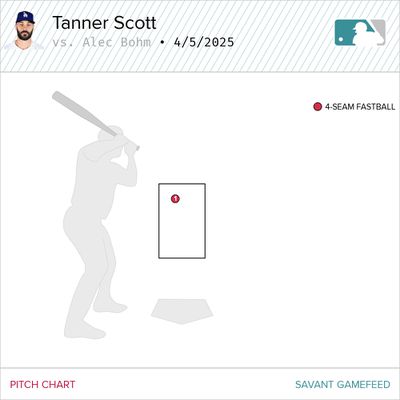
It came in at 95.7 MPH, but that is an elevated fastball practically in the middle of the strike zone. This is a good pitch to hit, but Bohm hits a soft liner off the end of his bat to shortstop for an easy double play.
Finally, here is the pitch that Max Kepler lifted into left field for the game ending out.
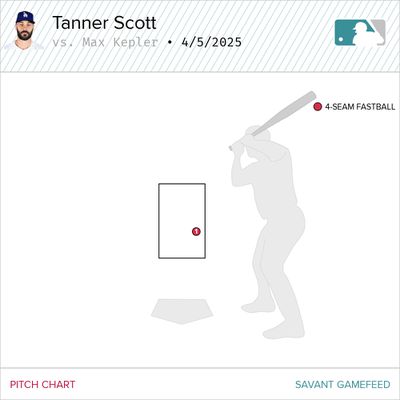
Again, this pitch came in around 97 MPH, but it was down, in, and over that plate. That is the nitro zone for left-handed hitters like Kepler. To his credit, he did give it a ride with a 102 MPH exit velocity the other way, but ultimately it was a lineout to left short of the warning track.
The point here is to illustrate that although a three-pitch inning is unacceptable, especially down two runs in the ninth inning, the Phillies really didn’t swing at any bad pitches. The worst one was the one that Harper actually reached base on. The biggest problem in this inning is that Bohm didn’t do anything with the pitch he got to hit. He finished the day seeing just five total pitches through four at-bats where he went 0-4 with an RBI groundout.
But flashback to Opening Day on March 27th, and Bohm had a very different result when swinging first pitch in a leverage situation. Here is the first pitch that Bohm turned on to rip a double into the gap in extra innings and give the Phillies a two-run lead with two outs already on the board.
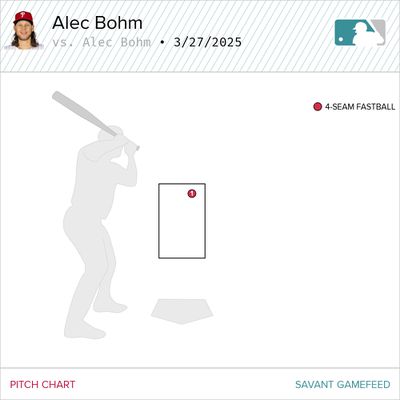
You’ll notice that it’s not in a much different location than the one Bohm hit into a double play with. It was slower at 93.3 MPH and Colin Poche is not Tanner Scott, but Bohm’s decision to swing at this first pitch looks smarter than the same decision from Saturday.
There are two keys when looking to swing first pitch. First, you have to make sure it’s a pitch in the zone and one you can hit. Second, you have to do damage to it. Bohm did the first step in both occasions, but he only did the second in the example from 3/27.
We’ve already mentioned how the Phillies put the first pitch into play at one of the highest rates in the Majors. They also have the sixth highest batting average (.400) and 11th best SLG (.700) on the first pitch. Perhaps there’s no better example of the benefits of first pitch swinging than Nick Castellanos’ grand slam from Sunday.
Rain never bothered Nick anyway#RingTheBell pic.twitter.com/0qkOGUNRrl
— Philadelphia Phillies (@Phillies) April 6, 2025
Here’s a better look at the pitch Castellanos hammered into the left field seats.
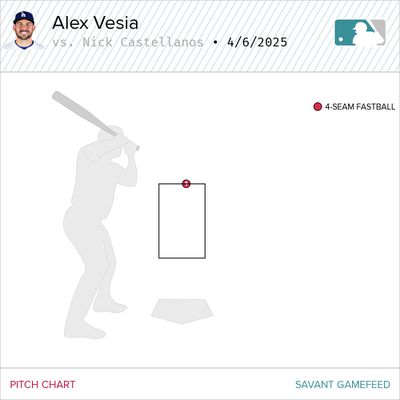
Once again, it’s a fastball, except this one was only 89 MPH and was right at the very top of the zone but still over the middle. Castellanos went up hunting a fastball from the new relief pitcher believing Vesia would want to get ahead with the bases loaded and no outs. He got that fastball, and he didn’t miss it.
So, is swinging at the first pitch a good or bad thing? Like almost anything in baseball, it depends on context and result. Bohm made a mistake when he hit into a double play but made a good decision when he hit a go-ahead double. Castellanos was a hero with his decision, but he was a poor swing away from being a goat.
If the first pitch isn’t hittable and you swing, you run the risk of falling behind in the count or making a feeble out. If it is hittable and you swing but don’t make good contact or miss it altogether, you run the same risks but also carry the possible reward of doing damage.
It’s a tradeoff with no easy answer. There are arguments for being aggressive on the first pitch as well as being passive and working the count. What we know for sure is that so far with this small sample size this season, the Phillies have generally had success swinging at the first pitch even if it’s resulted in a generally low number of pitches seen per game.
In 2024, the Phillies swung at the fifth most first pitches and hit .346 against them, seventh best in the Majors. Their .589 SLG% was ninth best. They also saw the 15th most pitches in general last season, right in the middle of the league. For comparison, the World Champion Dodgers swung at the ninth most first pitches but had the best AVG (.370) and SLG% (.663) on first pitches. L.A. saw the third most pitches in baseball.
First pitch swinging is a real yin and yang. It’s not inherently a bad thing but do it too much and you can down quietly. However, if you don’t do it enough, you miss on opportunities to hit hittable pitches. There is no foolproof philosophy, but rather players and teams need to find a balance.